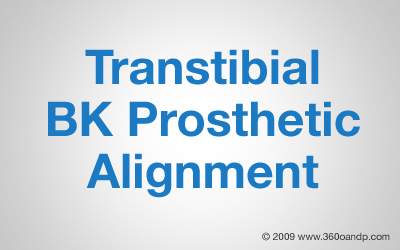
Helpful Terminology
Gait An individual’s walking pattern
Ambulation Walking
Alignment The spatial relationship between prosthetic components and the prosthetic user
Stance Phase A phase in the gait cycle, when the limb supports the body.
The stance phase includes heel strike (heel strike period), foot flat (midstance), heel off (push-off), and knee bend (acceleration).
Swing Phase A phase in the gait cycle, when the limb is ‘swinging’.
The swing phase includes toe off (initial swing with 10% knee flexion), toe clearance (midswing with knee with 80% knee extension), and ends with heel strike, in preparation for stance phase.
Anterior The front of the prosthesis/socket
Posterior The back of the prosthesis/socket
Varus Angled inward
Valgus Angled outward
Lateral Outside, or going away from the center of the body
Medial Inside, or going toward the center of the body
Bench Alignment Standard alignment with all alignment screws neutral.
Static Alignment Alignment evaluation while the prosthetic user is standing, with weight distributed equally on both limbs and feet approximately 10 cm apart.
Dynamic Alignment Alignment evaluation while the user is walking.
Flexion The process of bending
Extension The process of straightening
Adduction The movement of the limb towards the midline of the body
Abduction The movement of the limb away from the midline of the body
Plantar Flexion Toe pointing downward
Dorsi Flexion Toe pointing upward
Gait Deviation A departure from a smooth, natural walking pattern
Distal At the end
The transtibial, or below knee, prosthesis is comprised of 3 major components: the socket, the pylon, and the foot. Proper alignment of these components takes into consideration the user’s unique anatomy and component manufacturer guidelines.
Some of the goals for prosthetic alignment are:
· Even weight distribution on the residual limb
· Smooth, natural gait
· Less energy expenditure
· Cosmetic realism
Transtibial alignment should allow for a relatively narrow, natural gait and should require as little energy as possible to achieve ambulation. Cosmetic finishing is also a factor when determining alignment as many prosthetic users desire a natural leg shape.
A prosthesis experiences downward forces from the residual limb, in addition to the upward forces of the ground. If the socket and foot are not properly aligned, the socket can shift positions under force, and can hinder the user’s ambulation.
When a prosthesis is completed, but has yet to be fit on the user, the alignment is set to standard bench alignment. In this transtibial alignment setting, alignment screws are set to neutral positions. The prosthetist will perform both static and dynamic alignment observations, in order to adjust the prosthetic components. Users will typically walk along a parallel bar path while the prosthetist watches and makes occasional alignment adjustments.
Poor prosthetic alignment can result in discomfort, poor posture, and gait deviations. Some examples of this cause and effect are as follows:
Gait Deviation:
Knee remains extended during heel strike and midstance
Possible Alignment Cause(s):
· Foot heel is too soft
· Socket is not flexed enough
· Foot is too plantar flexed
Gait Deviation:
Knee in too much flexion during heel strike and midstance
Possible Alignment Cause(s):
· Foot heel is too hard
· Foot too far posterior
Gait Deviation:
Toe of foot rotating out during strike and midstance
Possible Alignment Cause(s):
· Foot too dorsiflexed
· Foot rotation to far lateral
· Too much foot inset
· Foot heel too hard
Gait Deviation:
Knee too varus during midstance
Possible Alignment Cause(s):
· Too much foot inset
Gait Deviation:
Too wide of a walking base during midstance
Possible Alignment Cause(s):
· Prosthesis too long
· Foot too far outset
Gait Deviation:
Knee too extended during midstance to toe off
Possible Alignment Cause(s):
· Foot too plantar flexed
Ideally, the prosthetic pylon should be vertical while the user is standing. The results of poor alignment can also be observed during static alignment observations:
User Position While Standing:
Pylon leaning posterior
Possible Alignment Cause(s):
· Foot too anterior
· Too much socket flexion
· Foot heel too soft
User Position While Standing:
Pylon leaning anterior
Possible Alignment Cause(s):
· Socket not flexed enough
User Position While Standing:
Excessively narrow standing base
Possible Alignment Cause(s):
· Foot inset too much
Observation of the prosthetic user while sitting is also required in order to ensure proper alignment. The user should be able to sit comfortably with at least 90 degrees of knee flexion, with both feet on the floor.
Alignment, though, is not always text book. Some amputees, particularly those with congenital amputation (amputation occurring during fetal development) also have skeletal abnormalities that can influence prosthetic alignment. For example, many persons with proximal femoral focal deficiency (PFFD) have femur and hip abnormalities that require unusual socket and component alignment. Also, an amputee with a curved tibia would require unusual pylon and foot alignment.
Amputees often underestimate the effect that shoe style has on prosthetic alignment. For example, switching to a higher shoe heel height without prosthetic alignment adjustment would result in too much dorsi flexion of the foot (the toe is too high up). In this case, the prosthetic user would feel as if he or she is falling forward. Conversely, switching to a lower shoe heel height without prosthetic adjustment would result in the toe being pointed too low, plantar flexion. In this case, the prosthetic user would feel as if he or she were falling forward.